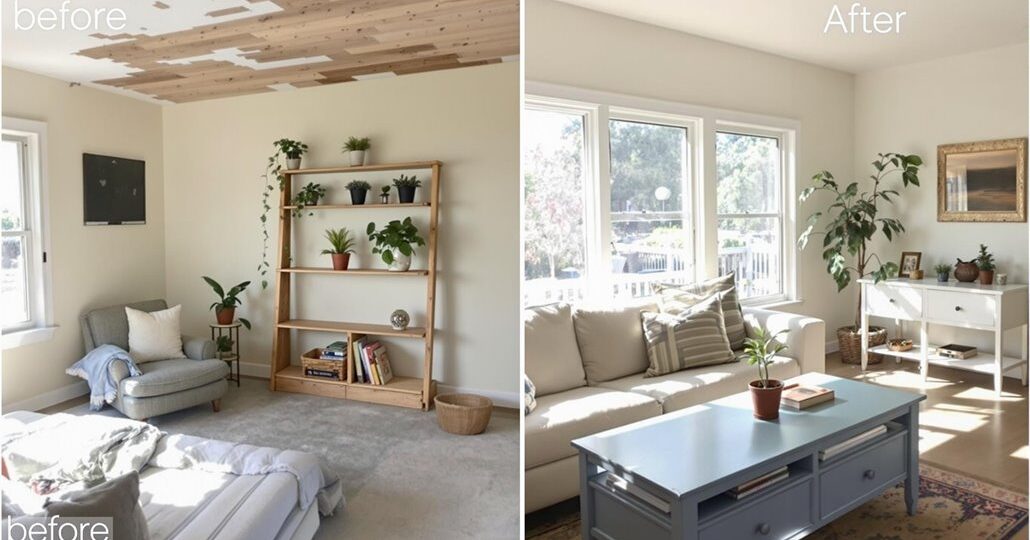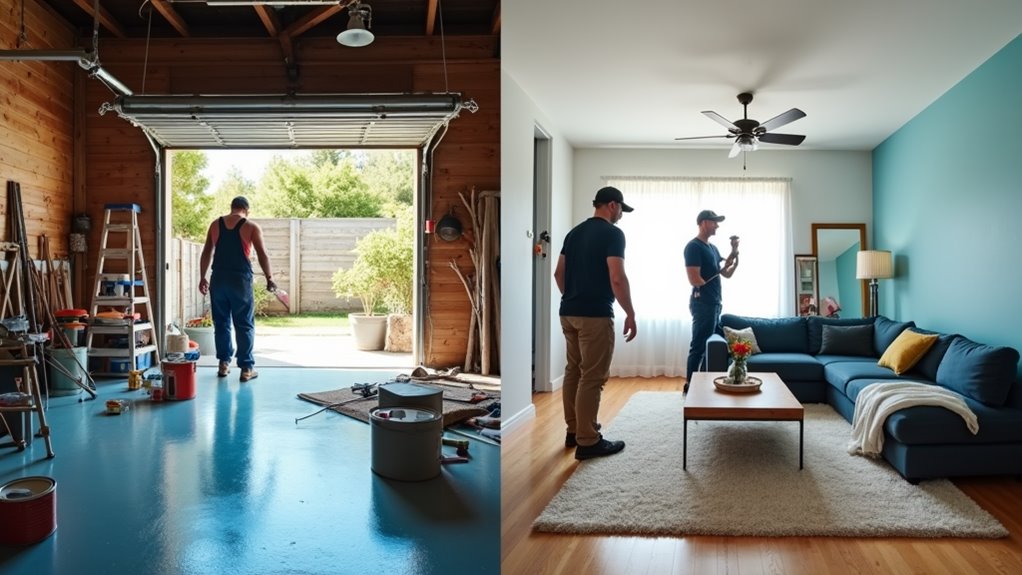
To save money on home renovations, start by setting a realistic budget and prioritizing essential projects. Decide if you want to tackle DIY tasks for savings or hire professionals for expertise. Shop smart for materials by comparing prices and taking advantage of sales. Stay flexible with design choices, as alternative options can be less costly yet equally charming. There are plenty more strategies to guarantee you get the best value for your renovation investments.
Key Takeaways
- Set a realistic budget, including a 10-20% buffer for unexpected expenses during renovations.
- Prioritize renovations by necessity and impact to focus on essential upgrades first.
- Shop smart for materials by comparing prices, exploring sales, and considering gently used options.
- Embrace flexibility in design choices to find affordable alternatives without compromising quality.
- Consider DIY for simpler projects, but evaluate your skills and time commitment before proceeding.
Set a Realistic Budget

What it Looks like: Setting a realistic budget for home renovations involves carefully evaluating your financial situation and determining how much you can comfortably allocate without compromising your other financial obligations. This means considering not only the cost of materials and labor but also factoring in potential unexpected expenses that may arise during the renovation process. A well-structured budget should break down costs into categories such as labor, materials, permits, and contingencies, allowing homeowners to get a clear picture of where their money is going. Additionally, it's wise to include a buffer—typically around 10-20%—for any surprises that might pop up along the way.
Why It's Smart: Creating a realistic budget is a vital step in ensuring that your renovation project does not become a financial burden. By establishing a clear financial plan, you can avoid overspending and the stress that comes with it. A well-thought-out budget also helps in prioritizing renovations, allowing homeowners to decide which projects are essential and which can wait. This strategic approach not only keeps finances in check but also helps in maintaining a focus on quality, ensuring that money is spent wisely on materials and workmanship that will add value to your home.
Things to Be Aware of: While setting a budget is essential, it's important to be aware that renovation costs can often exceed initial estimates due to various factors such as rising material prices, labor shortages, or unforeseen structural issues. Homeowners should remain flexible and open to adjusting their budgets as needed while still keeping a close eye on overall spending. Additionally, it's beneficial to research and gather multiple quotes from contractors to get a realistic understanding of labor costs. Finally, always remember to keep communication open with all parties involved, ensuring everyone is aligned with the budgetary constraints and expectations throughout the renovation process.
Prioritize Your Renovation Projects

What it Looks Like: Prioritizing your renovation projects means evaluating your home to identify which areas need immediate attention versus those that can wait. For example, if your kitchen appliances are outdated and inefficient, that might take precedence over a bathroom remodel that can be postponed. Creating a list of renovations, ranked by necessity and impact, can help you visualize where to allocate your budget most effectively. This approach not only helps in managing costs but also guarantees that you focus on projects that will enhance your home's functionality and value.
Why It's Smart: Prioritizing renovations is a strategic approach that allows you to maximize your investment. By focusing on fundamental upgrades first, such as fixing structural issues or improving energy efficiency, you can avoid larger expenses down the line. Additionally, completing high-priority projects can increase your home's market value, which can be especially beneficial if you plan to sell in the near future. This methodical approach also helps in budgeting, as you can allocate funds more effectively and avoid overspending on less critical updates.
Things to Be Aware of: While prioritizing projects, it's important to remain flexible and realistic about your home's needs. Sometimes unforeseen issues can arise, such as hidden water damage or outdated wiring, which may require you to shift your focus unexpectedly. Additionally, consider the potential for overlapping projects; for instance, if you're planning to update your kitchen and bathroom, doing both at the same time might save on labor costs. Always keep in mind the importance of obtaining multiple quotes from contractors and being aware of market trends to guarantee you're making informed decisions that align with your renovation priorities.
DIY vs. Hiring Professionals

What it Looks like: When considering home renovations, homeowners often face the dilemma of whether to take on the project themselves (DIY) or hire professionals. A DIY approach might involve a family painting a room, creating new landscaping, or even tackling more complex tasks such as tiling a bathroom or building a deck. The allure of DIY lies in the satisfaction of completing a project with one's own hands and the potential for significant cost savings. On the other hand, hiring professionals can provide a polished finish and guarantee that work is done to code and with the right materials. Professional contractors might bring expertise and efficiency that can be difficult to achieve alone, particularly for larger or more technical projects.
Why It's Smart: Choosing to DIY can save homeowners a substantial amount of money, as labor costs typically make up a large portion of renovation expenses. Additionally, engaging in DIY projects can enhance one's skills and knowledge about home maintenance and repair, leading to additional savings down the line. However, hiring professionals can be equally wise in certain circumstances. Professionals possess experience, industry knowledge, and access to high-quality materials that can boost the longevity of renovations. Furthermore, they often have insurance and warranties that can protect the homeowner from future costs associated with repairs or fixes that might arise from DIY mistakes.
Things to Be Aware of: It's essential to evaluate personal skill levels and the complexity of the project before deciding on a DIY approach. Some renovations may seem straightforward but can quickly become overwhelming without proper tools or expertise. In addition, time is an important factor; DIY projects can take longer than expected, especially if one is juggling work and family obligations. On the flip side, hiring professionals requires careful vetting to avoid unreliable contractors or unexpected costs. Homeowners should always seek multiple quotes and check references to confirm they're making an informed decision. Balancing the desire for savings with the need for quality and safety is vital when managing the DIY versus professional hiring debate.
Shop Smart for Materials

What it Looks Like:
When shopping smart for materials during home renovations, you will often find yourself exploring a variety of options, both online and in local stores. This could mean visiting hardware stores, checking out discount outlets, and exploring online marketplaces. You'll want to compare prices, look for sales, and consider purchasing gently used or surplus materials. For instance, reclaimed wood can add character to your home while being more affordable than brand-new lumber. Additionally, researching materials and their costs beforehand can help you make informed decisions, allowing you to set a budget that aligns with your renovation goals.
Why It's Smart:
Shopping smart for materials not only helps you save money but also encourages you to be resourceful and creative in your renovation approach. By taking the time to compare prices and seek out deals, you can often find high-quality materials that fit your budget without sacrificing aesthetics or durability. This approach allows you to allocate funds to other areas of the renovation, such as labor costs or additional features that enhance your home's value. Furthermore, purchasing materials in bulk or during clearance sales can yield significant savings, enabling you to stretch your renovation budget further.
Things to Be Aware of:
While shopping smart can lead to substantial savings, it's important to be cautious about the quality of the materials you choose. Not all discounted or second-hand items are suitable for your renovation needs, as they may have hidden defects or may not meet building codes. Additionally, be wary of the potential for mismatched materials if you are sourcing items from different places, as this can impact the overall look and feel of your renovation. Finally, always factor in shipping costs or potential delays when ordering materials online, as these can affect your budget and timeline. Being diligent in your research and cautious in your selections will help guarantee a successful and cost-effective renovation project.
Be Flexible With Design Choices

What it Looks like: Being flexible with design choices in home renovations can manifest in various ways, such as opting for alternative materials, colors, or layouts than originally planned. For instance, if you had your heart set on a specific type of granite countertop but find it outside your budget, considering quartz or even laminate can yield a similar aesthetic at a fraction of the cost. Similarly, if you envisioned an open-concept floor plan but the structural changes prove too costly, you might explore creative furniture arrangements or partial walls that maintain an airy feel without the hefty price tag. This flexibility not only allows for potential savings but can also lead to discovering unexpected styles that enhance your home's charm.
Why It's Smart: Embracing flexibility in your design choices can lead to significant cost savings while still achieving a beautiful and functional space. By being open to alternative options, you can take advantage of sales, discounts, or even locally sourced materials that might not have been on your radar initially. This adaptability also means you're more likely to find solutions that fit your budget without compromising quality. Additionally, working with a skilled contractor who values creativity can yield innovative ideas that align with your vision while being mindful of financial constraints. Ultimately, this approach fosters a more enjoyable renovation experience, reducing stress and allowing for a more collaborative design process.
Things to Be Aware of: While being flexible with design choices can open up new opportunities for savings, it's crucial to remain mindful of the overall vision for your home. Confirm that any changes align with your long-term goals and the existing style of your property to avoid a mismatched aesthetic down the line. Moreover, while exploring alternatives, be cautious of compromising on quality; lower-cost materials might save you money upfront but could lead to higher maintenance costs or premature replacements. Finally, maintain clear communication with your contractor about your flexibility; this transparency will help them to propose the best options that fit your budget while still delivering a satisfactory outcome for your renovation project.
RELATED POSTS
View all


